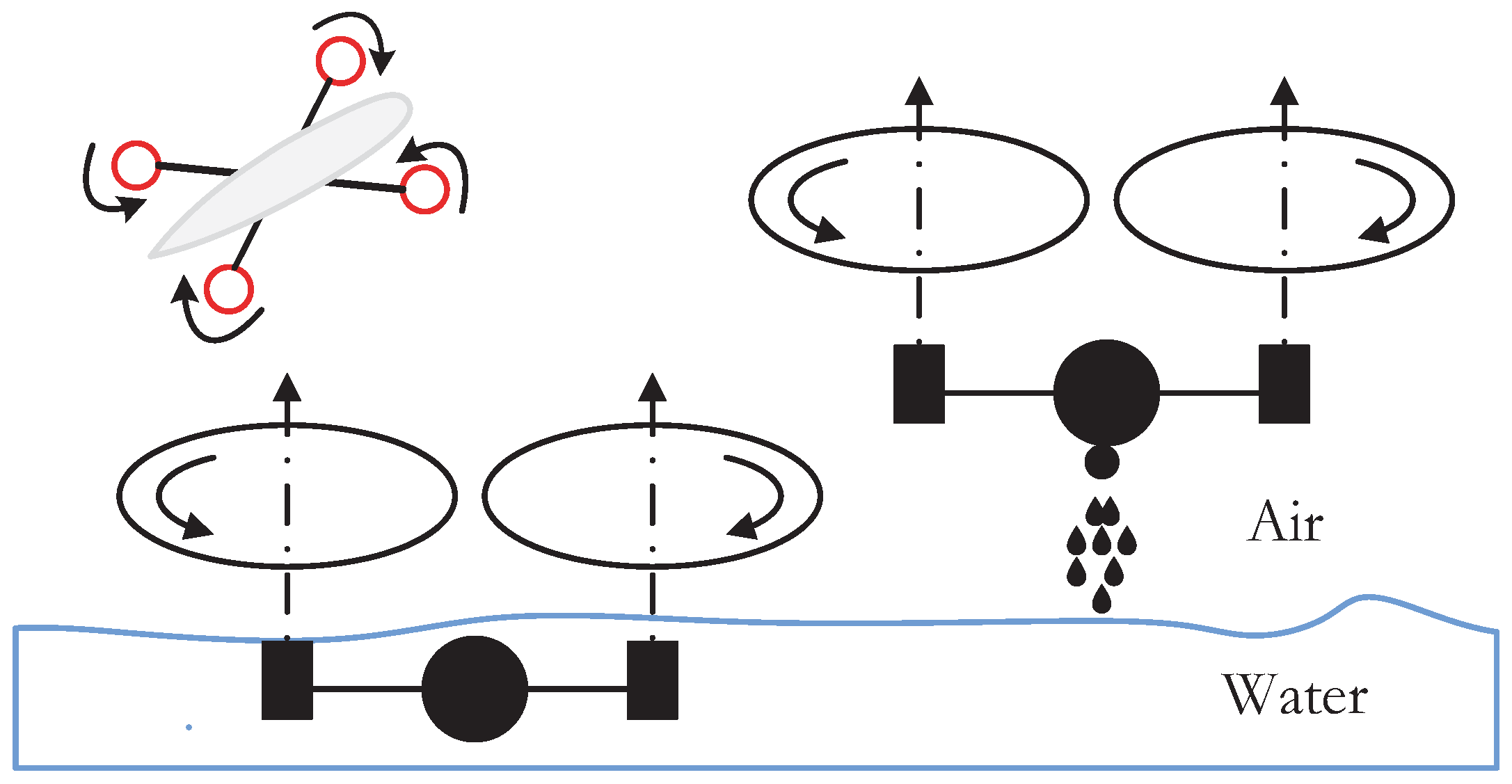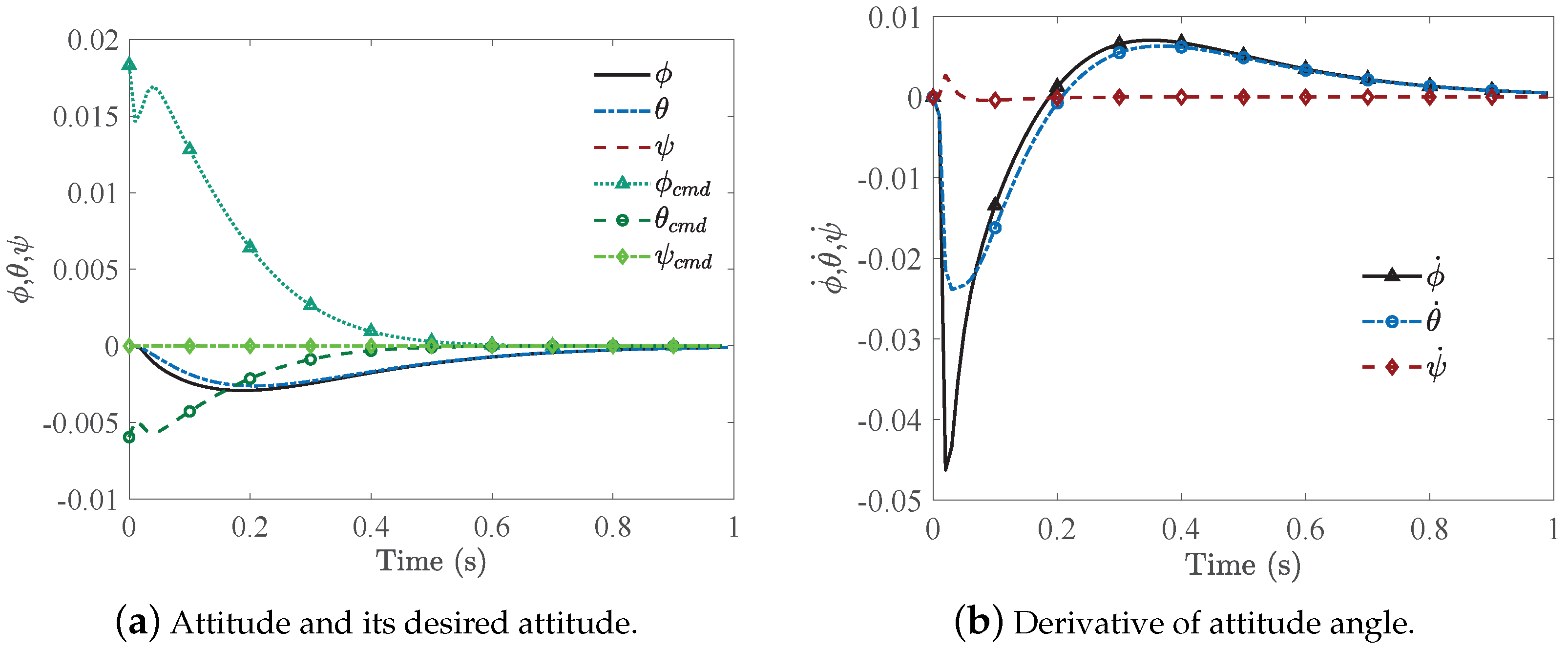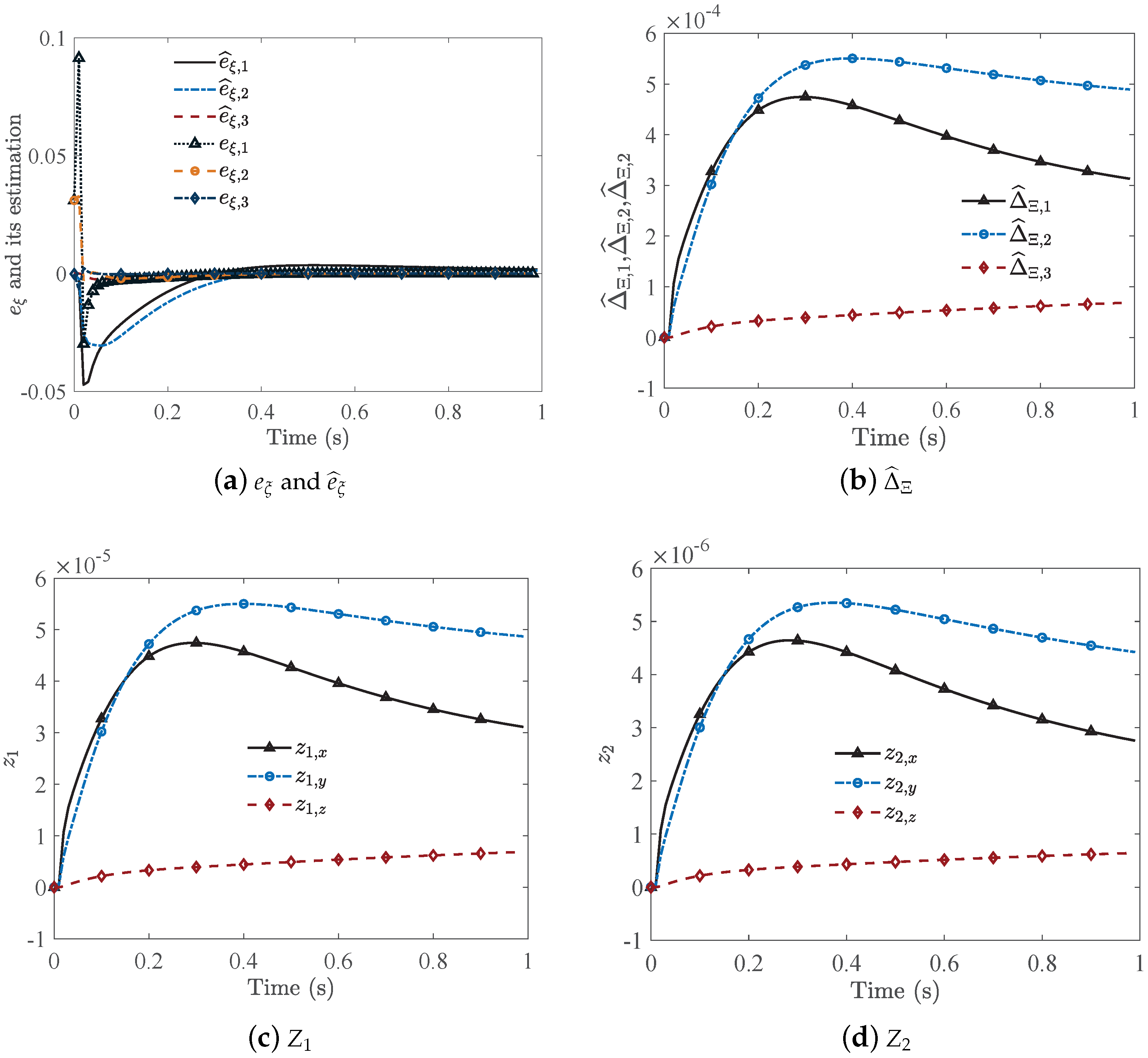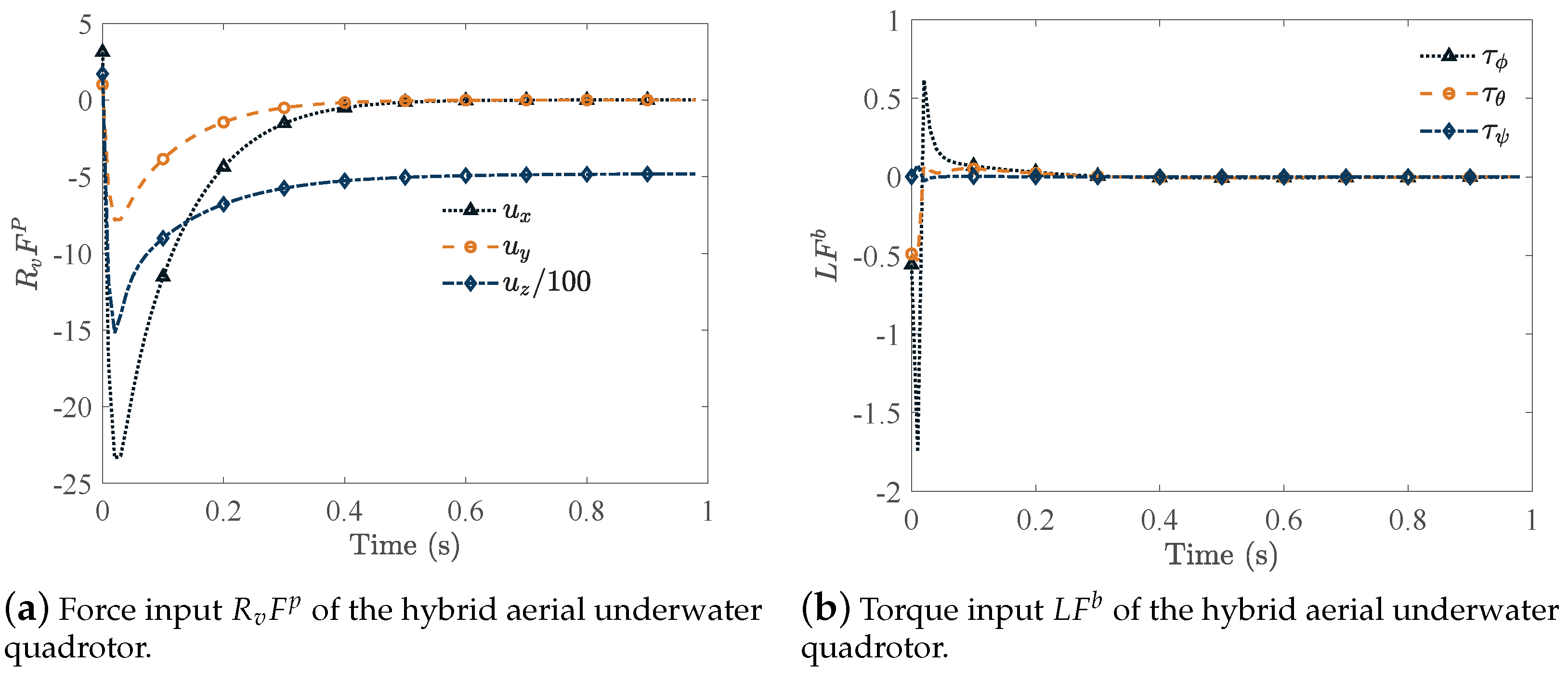Disturbance Observer-Based Robust Take-Off Control for a Semi-Submersible Permeable Slender Hybrid Unmanned Aerial Underwater Quadrotor
Abstract
:1. Introduction
- A new water–air trans-medium pattern is proposed for the HAUQ with a permeable slender body. Compared with the existing layouts of the HAUVs, the HAUQs with a permeable slender body can help to keep the streamlined fuselage needed for underwater and air navigation.
- A general mathematical model is established for HAUQs by employing the Newton–Euler formulation as the factors exist, including the strong uncertainties caused by the fluid dynamics in the complex water–air mixed environment, the fast time-varying added mass caused by the fluid dynamics and the residual water inside the slender body, the influence of the passive drainage, and the external disturbance.
- A disturbance observer-based robust control scheme is proposed for HAUQs. The robust control is adopted to compensate for the fast time-varying mass uncertainty. For the uncertainties of the multi-media complex dynamics modeling on the position and attitude dynamic equations, it is estimated by considering it as a combination of the specific basis functions, and an adaptive method is used to estimate the unknown weight parameters. The rapid and uncontrollable drainage will cause the mass and the center of mass to change during take-off on the water surface. Meanwhile, the length of the arm of force and the moment of inertia matrix will change unpredictably, and they are considered as the bounded uncertainty of the moment of inertia matrix and the force arm variation. Then, a comprehensive dynamic disturbance term is formed together with the bounded additional disturbances, and a disturbance observer structure in [19] is introduced to estimate it under the assumption that the total disturbance is measurable. The idea of using a disturbance observer to estimate the system disturbances is to introduce feedforward compensation in the process of controller design to improve the control performance of the system, and it is widely used in aircraft control [20,21,22,23,24,25,26,27,28,29]. The input-to-state stability theorem is an effective method to study nonlinear systems with noises and disturbances [30]. This method can obtain the bounded states by suppressing the bounded disturbances; therefore, the stability of the position and attitude control of the HAUQ is analyzed by the input–state stability theorem. Finally, a nonlinear robust control algorithm is proposed consisting of three parts: a nonlinear robust take-off controller for HAUQs, an adaptive control law, and a disturbance observer. The simulation results show the effectiveness of the proposed algorithm.
2. Mathematical Model
2.1. Dynamic Model of Water Surface Take-Off in Body Coordinate System
2.2. Dynamic Model of Water Surface Take-Off in Inertial Coordinate System
3. Nonlinear Robust Control Laws
3.1. Control Model of Water Surface Take-Off
3.2. Robust Adaptive Position Controller Water–Air Crossing
3.3. Nonlinear Attitude Controller Based on Disturbance Observer
4. Simulation Results
5. Conclusions
Author Contributions
Funding
Institutional Review Board Statement
Informed Consent Statement
Data Availability Statement
Acknowledgments
Conflicts of Interest
References
- Shkurti, F.; Xu, A.; Meghjani, M.; Higuera, J.C.G.; Girdhar, Y.; Giguere, P.; Dudek, G. Multi-domain monitoring of marine environments using a heterogeneous robot team. In Proceedings of the IEEE/RSJ International Conference on Intelligent Robots and Systems, Algarve, Portugal, 7–12 October 2012; pp. 1747–1753. [Google Scholar]
- Murphy, R.R.; Steimle, E.; Griffin, C.; Cullins, C.; Hall, M.; Pratt, K. Cooperative use of unmanned sea surface and micro aerial vehicles at Hurricane Wilma. J. Field Robot. 2008, 25, 164–180. [Google Scholar] [CrossRef]
- Yuan, C.; Licht, S.; He, H. Formation learning control of multiple autonomous underwater vehicles with heterogeneous nonlinear uncertain dynamics. IEEE Trans. Cybern. 2017, 48, 2920–2934. [Google Scholar] [CrossRef] [PubMed]
- Izraelevitz, J.S.; Triantafyllou, M.S. A novel degree of freedom in flapping wings shows promise for a dual aerial/aquatic vehicle propulsor. In Proceedings of the IEEE International Conference on Robotics and Automation (ICRA), Xi’an, China, 30 May–5 June 2015; pp. 5830–5837. [Google Scholar]
- Lu, D.; Xiong, C.; Lyu, B.; Zeng, Z.; Lian, L. Multi-mode hybrid aerial underwater vehicle with extended endurance. In Proceedings of the OCEANS-MTS/IEEE Kobe Techno-Oceans (OTO), Kobe, Japan, 28–31 May 2018; pp. 1–7. [Google Scholar]
- Yu, C.; Xiang, X.; Wilson, P.A.; Zhang, Q. Guidance-error-based robust fuzzy adaptive control for bottom following of a flight-style AUV with saturated actuator dynamics. IEEE Trans. Cybern. 2019, 50, 1887–1899. [Google Scholar] [CrossRef]
- Wu, Y.; Li, L.; Su, X.; Gao, B. Dynamics modeling and trajectory optimization for unmanned aerial-aquatic vehicle diving into the water. Aerosp. Sci. Technol. 2019, 89, 220–229. [Google Scholar] [CrossRef]
- Chen, Y.; Helbling, E.; Gravish, N.; Ma, K.; Wood, R.J. Hybrid aerial and aquatic locomotion in an at-scale robotic insect. In Proceedings of the IEEE/RSJ International Conference on Intelligent Robots and Systems (IROS), Hamburg, Germany, 28 September–2 October 2015; pp. 331–338. [Google Scholar]
- Lu, D.; Xiong, C.; Zeng, Z.; Lian, L. Adaptive dynamic surface control for a hybrid aerial underwater vehicle with parametric dynamics and uncertainties. IEEE J. Ocean. Eng. 2019, 45, 740–758. [Google Scholar] [CrossRef]
- Stewart, W.; Weisler, W.; Anderson, M.; Bryant, M.; Peters, K. Dynamic modeling of passively draining structures for aerial–aquatic unmanned vehicles. IEEE J. Ocean. Eng. 2020, 45, 840–850. [Google Scholar] [CrossRef]
- Gao, J.; Proctor, A.; Shi, Y.; Bradley, C. Hierarchical model predictive image-based visual servoing of underwater vehicles with adaptive neural network dynamic control. IEEE Trans. Cybern. 2015, 46, 2323–2334. [Google Scholar] [CrossRef]
- Wei, T.; Lu, D.; Zeng, Z.; Lian, L. Trans-media kinematic stability analysis for hybrid unmanned aerial underwater vehicle. J. Mar. Sci. Eng. 2022, 10, 275. [Google Scholar] [CrossRef]
- Drews, P.; Neto, A.; Campos, M. Hybrid unmanned aerial underwater vehicle: Modeling and simulation. In Proceedings of the IEEE/RSJ International Conference on Intelligent Robots and Systems, Chicago, IL, USA, 14–18 September 2014; pp. 4637–4642. [Google Scholar]
- Du, X.X.; Song, B.W.; Pan, G. Effect of wave and ocean current to motion of low-velocity UUV. Key Eng. Mater. 2011, 467, 75–79. [Google Scholar] [CrossRef]
- Teo, H.; Eng, H. A Robust AUV Docking Guidance and Navigation Approach to Handling Unknown Current Disturbances; M. S. Florida Atlantic University: Boca Raton, FL, USA, 2010. [Google Scholar]
- Hegrenes, O.; Hallingstad, O.; Jalving, B. A framework for obtaining steady-state maneuvering characteristics of underwater vehicles using sea-trial data. In Proceedings of the Mediterranean Conference on Control and Automation, Athens, Greece, 27–29 July 2007. [Google Scholar]
- Chen, W.U.; Jianbo, S.U. Trajectory tracking of quadrotor based on disturbance rejection control. Control. Theorey Appl. 2016, 33, 1422–1430. [Google Scholar]
- Carrillo, L.; Flores, G.; Sanahuja, G.; Lozano, R. Quad rotorcraft swithcing control: An application for the task of path following. IEEE Trans. Control. Syst. Technol. 2013, 22, 99. [Google Scholar]
- Sira-Ramrez, H.; Cortes-Romero, J.; Luviano-Juzrez, A. Robust linear control of nonlinear flat systems. Robust Control. Theory Appl. 2010, 20, 455–477. [Google Scholar]
- Yang, H.; Cheng, L.; Xia, Y.; Yuan, Y. Active disturbance rejection attitude control for a dual closed-loop quadrotor under gust wind. IEEE Trans. Control. Syst. Technol. 2018, 26, 1400–1405. [Google Scholar] [CrossRef]
- Chang, K.; Ma, D.; Li, T.; Xia, Y. Active disturbance rejection and predictive control strategy for a quadrotor helicopter. IET Control. Theory Appl. 2016, 10, 2213–2222. [Google Scholar]
- Lee, S.J.; Kim, S.; Johansson, K.H.; Kim, H.J. Robust acceleration control of a hexarotor UAV with a disturbance observer. In Proceedings of the IEEE 55th Conference on Decision and Control (CDC), Las Vegas, NV, USA, 12–14 December 2016; pp. 4166–4171. [Google Scholar]
- Chen, M.; Xiong, S.; Wu, Q. Tracking flight control of quadrotor based on disturbance observer. IEEE Trans. Syst. Man, Cybern. Syst. 2019, 1–10. [Google Scholar] [CrossRef]
- Xiao, B.; Yin, S. A new disturbance attenuation control scheme for quadrotor unmanned aerial vehicles. IEEE Trans. Ind. Inform. 2017, 13, 2922–2932. [Google Scholar] [CrossRef]
- Castillo, A.; Sanz, R.; Garcia, P.; Qiu, W.; Wang, H.; Xu, C. Disturbance observer-based quadrotor attitude tracking control for aggressive maneuvers. Control. Eng. Pract. 2019, 82, 14–23. [Google Scholar] [CrossRef]
- Wang, L.; Su, J. Robust disturbance rejection control for attitude tracking of an aircraft. IEEE Trans. Control. Syst. Technol. 2015, 23, 2361–2368. [Google Scholar] [CrossRef]
- Yang, J.Q.; Zhu, F.L. Linear-matrix-inequality observer design of nonlinear systems with unknown input and measurement noise reconstruction. Control. Theory Appl. 2014, 31, 538–544. [Google Scholar]
- Yang, J.; Li, S.; Sun, C.; Guo, L. Nonlinear-disturbance-observerbased robust flight control for airbreathing hypersonic vehicles. IEEE Trans. Aerosp. Electron. Syst. 2013, 49, 1263–1275. [Google Scholar] [CrossRef]
- Bu, X.; Wu, X.; Chen, Y.; Chen, Y.; Bai, R. Nonlinear disturbance-observer-based sliding mode backstepping control of hypersonic vehicle. Control. Theory Appl. 2014, 31, 1473–1479. [Google Scholar]
- Sontag, E. Input to state stability: Basic concepts and results. In Proceedings of the Lecture Notes in Mathematics, CIME Course, Cetraro, Italy, 19–29 June 2004. [Google Scholar]







Disclaimer/Publisher’s Note: The statements, opinions and data contained in all publications are solely those of the individual author(s) and contributor(s) and not of MDPI and/or the editor(s). MDPI and/or the editor(s) disclaim responsibility for any injury to people or property resulting from any ideas, methods, instructions or products referred to in the content. |
© 2023 by the authors. Licensee MDPI, Basel, Switzerland. This article is an open access article distributed under the terms and conditions of the Creative Commons Attribution (CC BY) license (https://creativecommons.org/licenses/by/4.0/).
Share and Cite
Liao, F.; Ye, D. Disturbance Observer-Based Robust Take-Off Control for a Semi-Submersible Permeable Slender Hybrid Unmanned Aerial Underwater Quadrotor. Appl. Sci. 2023, 13, 9318. https://doi.org/10.3390/app13169318
Liao F, Ye D. Disturbance Observer-Based Robust Take-Off Control for a Semi-Submersible Permeable Slender Hybrid Unmanned Aerial Underwater Quadrotor. Applied Sciences. 2023; 13(16):9318. https://doi.org/10.3390/app13169318
Chicago/Turabian StyleLiao, Fei, and Dezhang Ye. 2023. "Disturbance Observer-Based Robust Take-Off Control for a Semi-Submersible Permeable Slender Hybrid Unmanned Aerial Underwater Quadrotor" Applied Sciences 13, no. 16: 9318. https://doi.org/10.3390/app13169318
APA StyleLiao, F., & Ye, D. (2023). Disturbance Observer-Based Robust Take-Off Control for a Semi-Submersible Permeable Slender Hybrid Unmanned Aerial Underwater Quadrotor. Applied Sciences, 13(16), 9318. https://doi.org/10.3390/app13169318





